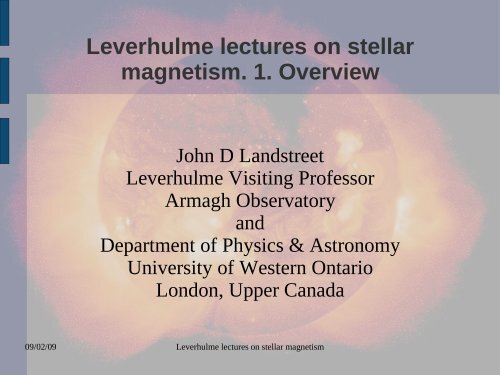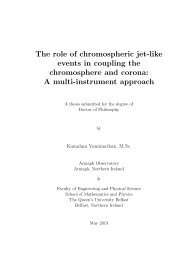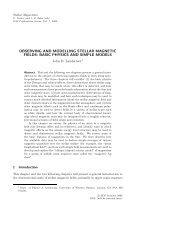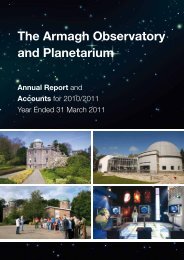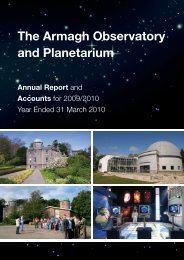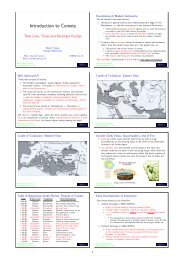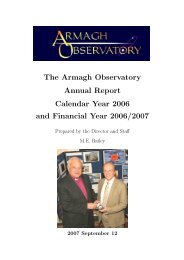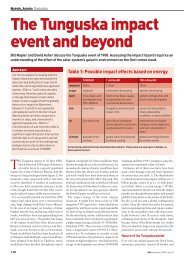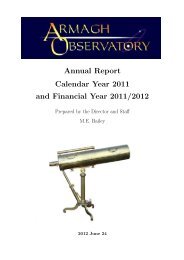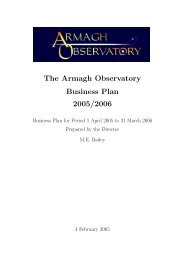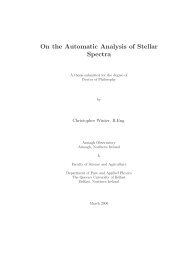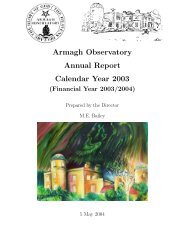Lecture 1, an introduction to stellar magnetism - Armagh Observatory
Lecture 1, an introduction to stellar magnetism - Armagh Observatory
Lecture 1, an introduction to stellar magnetism - Armagh Observatory
Create successful ePaper yourself
Turn your PDF publications into a flip-book with our unique Google optimized e-Paper software.
Leverhulme lectures on <strong>stellar</strong><br />
<strong>magnetism</strong>. 1. Overview<br />
John D L<strong>an</strong>dstreet<br />
Leverhulme Visiting Professor<br />
<strong>Armagh</strong> Observa<strong>to</strong>ry<br />
<strong>an</strong>d<br />
Department of Physics & Astronomy<br />
University of Western Ontario<br />
London, Upper C<strong>an</strong>ada<br />
09/02/09<br />
Leverhulme lectures on <strong>stellar</strong> <strong>magnetism</strong>
Stellar Magnetic Fields<br />
Introduction<br />
●<br />
●<br />
●<br />
●<br />
We study <strong>stellar</strong> physics <strong>to</strong> underst<strong>an</strong>d<br />
– How <strong>to</strong> get information about dist<strong>an</strong>t objects from observations<br />
– How <strong>to</strong> underst<strong>an</strong>d <strong>stellar</strong> structure, evolution, <strong>an</strong>d observed<br />
phenomena such as X-ray emission or explosions<br />
Stellar physics employs mech<strong>an</strong>ics, thermodynamics,<br />
electricity & <strong>magnetism</strong>, qu<strong>an</strong>tum <strong>an</strong>d nuclear physics, etc<br />
One category of phenomena that might be present in stars,<br />
<strong>an</strong>d might be import<strong>an</strong>t for underst<strong>an</strong>ding <strong>stellar</strong> structure<br />
or evolution, <strong>an</strong>d for interpretation of spectra, is presence of<br />
a magnetic field B<br />
C<strong>an</strong> we detect magnetic fields? How? What c<strong>an</strong> we learn<br />
about their possible import<strong>an</strong>ce?<br />
09/02/09<br />
Leverhulme lectures on <strong>stellar</strong> <strong>magnetism</strong>
Detection of magnetic fields:<br />
the Zeem<strong>an</strong> effect <strong>an</strong>d its relatives<br />
●<br />
●<br />
●<br />
●<br />
●<br />
●<br />
For detailed study of stars, spectra are particularly powerful<br />
data because of rich information content of lines<br />
Spectral lines arise from a<strong>to</strong>mic tr<strong>an</strong>sitions between two<br />
energy states or levels<br />
Detection of magnetic field is possible because energy<br />
levels of a<strong>to</strong>ms <strong>an</strong>d ions are perturbed by a field, hence<br />
spectral lines are altered<br />
Perturbation occurs because a<strong>to</strong>ms are little bar magnets μ<br />
due <strong>to</strong> electron orbits <strong>an</strong>d intrinsic spin, so energy of a state<br />
depends on orientation of a<strong>to</strong>m in magnetic field as μ̛∘B<br />
Since different orientations are possible, single energy<br />
levels split in B field in<strong>to</strong> multiple levels<br />
Hence single spectral lines also split in<strong>to</strong> multiple lines<br />
09/02/09<br />
Leverhulme lectures on <strong>stellar</strong> <strong>magnetism</strong>
Example: Zeem<strong>an</strong> line components<br />
09/02/09<br />
Leverhulme lectures on <strong>stellar</strong> <strong>magnetism</strong>
Observing the Zeem<strong>an</strong> effect<br />
●<br />
●<br />
●<br />
●<br />
●<br />
Level splitting <strong>an</strong>d hence line splitting increases with<br />
increasing B as ∆E ~ (eh/4πmc)B<br />
To be visible, magnetic line splitting must compete with<br />
other line broadening mech<strong>an</strong>isms (thermal, rotational, etc)<br />
Splitting becomes detectable in (some) <strong>stellar</strong> spectra for B<br />
larger th<strong>an</strong> a few kG (a fraction of 1 T)<br />
The different line components (π <strong>an</strong>d σ) also have distinctive<br />
polarisation properties (e.g. in longitudinal field π<br />
components v<strong>an</strong>ish <strong>an</strong>d σ components on opposite sides of<br />
non-magnetic line wavelength have opposite circular<br />
polarisation)<br />
The polarisation properties make it possible <strong>to</strong> detect fields<br />
as small as a few G – if we have enough pho<strong>to</strong>ns....<br />
09/02/09<br />
Leverhulme lectures on <strong>stellar</strong> <strong>magnetism</strong>
Zeem<strong>an</strong> splitting in HD 94660<br />
●<br />
●<br />
Upper: <strong>stellar</strong><br />
spectrum<br />
showing<br />
Zeem<strong>an</strong><br />
splitting of<br />
lines ~6 kG<br />
Lower:<br />
labora<strong>to</strong>ry<br />
splitting of<br />
various lines in<br />
spectrum, π<br />
above <strong>an</strong>d σ<br />
below line<br />
09/02/09<br />
Leverhulme lectures on <strong>stellar</strong> <strong>magnetism</strong>
Polarisation in <strong>stellar</strong> spectral lines<br />
●<br />
●<br />
●<br />
●<br />
●<br />
In figure, left column is for<br />
field along line of sight, right<br />
is for field tr<strong>an</strong>sverse <strong>to</strong> sight<br />
line<br />
Top row: splitting of some<br />
typical line in lab<br />
2nd row: effects on<br />
unpolarised absorption line –<br />
little ch<strong>an</strong>ge in shape<br />
3rd row: spectral line as seen<br />
in left & right or parallel &<br />
perpendicular polarisation<br />
Last row: net polarisations<br />
09/02/09<br />
Leverhulme lectures on <strong>stellar</strong> <strong>magnetism</strong>
C<strong>an</strong> we detect & measure <strong>stellar</strong> fields<br />
with the physics discussed so far?<br />
●<br />
●<br />
●<br />
●<br />
●<br />
●<br />
09/02/09<br />
Hale (1908) observed splitting of spectral lines in spectra of<br />
Sun obtained with long slit covering a sunspot<br />
Verified that effect is magnetic by demonstrating (with circular<br />
polarisation <strong>an</strong>alyser) that line components are circularly<br />
polarised<br />
From separation of line components, estimate that fields of<br />
sunspots are ~3000 G<br />
Sunspots <strong>an</strong>d their fields come <strong>an</strong>d go on time scales of<br />
weeks<br />
Now unders<strong>to</strong>od that all solar “activity” -- sunspots, flares,<br />
filaments <strong>an</strong>d prominences, X-ray emission – is essentially<br />
magnetic in origin<br />
Other cool stars also show magnetic fields; strength depends<br />
strongly on rotation rate (faster rotation => larger B)<br />
Leverhulme lectures on <strong>stellar</strong> <strong>magnetism</strong>
Hale's detection of sunspot field<br />
●<br />
●<br />
Left image: view of<br />
sunspot on slit pl<strong>an</strong>e<br />
(slit is vertical line)<br />
Right: spectrum<br />
(dispersed<br />
horizontally) with<br />
Zeem<strong>an</strong> splitting at<br />
location of spot<br />
09/02/09<br />
Leverhulme lectures on <strong>stellar</strong> <strong>magnetism</strong>
Solar pho<strong>to</strong>sphere is “simple”,<br />
(almost) dominated by gas energy<br />
09/02/09<br />
Leverhulme lectures on <strong>stellar</strong> <strong>magnetism</strong>
Solar corona in X-rays – solar activity<br />
is a completely magnetic phenomenon<br />
09/02/09<br />
Leverhulme lectures on <strong>stellar</strong> <strong>magnetism</strong>
Magnetic observations of AB Dor<br />
09/02/09<br />
Leverhulme lectures on <strong>stellar</strong> <strong>magnetism</strong>
Fields of middle <strong>an</strong>d upper main<br />
sequence stars<br />
●<br />
●<br />
●<br />
●<br />
●<br />
●<br />
●<br />
09/02/09<br />
A few % of stars above 2 M o<br />
show magnetic fields<br />
Fields are usually detected by polarisation properties of<br />
Zeem<strong>an</strong> effect (measures rather th<strong>an</strong> |B|)<br />
These fields are intrinsically static, ch<strong>an</strong>ges only<br />
because star rotates <strong>an</strong>d we see different sides<br />
Fields r<strong>an</strong>ge from 300 <strong>to</strong> 30,000 G in different stars<br />
These magnetic stars (“magnetic Ap stars”) show very<br />
unusual atmospheric chemistry – underabund<strong>an</strong>t He, O;<br />
overabund<strong>an</strong>t Si, Cr, Sr, rare earths....<br />
Surface abund<strong>an</strong>ces vary over surface <strong>an</strong>d with height in<br />
atmosphere!<br />
Ap stars rotate unusually slowly, some with periods of m<strong>an</strong>y<br />
years<br />
Leverhulme lectures on <strong>stellar</strong> <strong>magnetism</strong>
Typical Ap stars variations (HD 184927)<br />
● Top: <br />
●<br />
●<br />
variations<br />
Middle: He line<br />
strength<br />
(equivalent width)<br />
Bot<strong>to</strong>m:<br />
brightness<br />
variations in<br />
Stromgren u<br />
b<strong>an</strong>d<br />
09/02/09<br />
Leverhulme lectures on <strong>stellar</strong> <strong>magnetism</strong>
●<br />
●<br />
●<br />
●<br />
Variation of B over<br />
surface of 53 Cam<br />
deduced from<br />
polarised spectra<br />
Columns show star<br />
with steps of 0.2 in<br />
rotational phase<br />
Three pairs of rows<br />
are maps from three<br />
lines of Fe II<br />
Colourful balls are<br />
maps of |B|, hairy<br />
balls show vec<strong>to</strong>r B<br />
09/02/09<br />
Leverhulme lectures on <strong>stellar</strong> <strong>magnetism</strong>
Measurement of huge magnetic fields<br />
of white dwarf stars<br />
●<br />
●<br />
●<br />
●<br />
In fields of more th<strong>an</strong> ~100 MG, magnetic energy in a<strong>to</strong>m is<br />
comparable <strong>to</strong> Coulomb energy, <strong>an</strong>d computation of a<strong>to</strong>mic<br />
absorption (line <strong>an</strong>d continuum) becomes really difficult<br />
The fact that free electrons spiral around magnetic field lines<br />
in a particular sense me<strong>an</strong>s that continuum absorption is<br />
dichroic. Right <strong>an</strong>d left circularly polarised light will be<br />
absorbed differently, <strong>an</strong>d the continuum radiation will be<br />
circularly polarised by a field that has large component<br />
along the line of sight.<br />
Observable continuum circular polarisation is found above<br />
about 10 MG.<br />
For still larger fields (above about 100 MG) a similar effect<br />
produces linear polarisation of continuum radiation.<br />
09/02/09<br />
Leverhulme lectures on <strong>stellar</strong> <strong>magnetism</strong>
White dwarf fields<br />
● Magnetic fields found in 50+<br />
isolated white dwarfs, <strong>an</strong>d 40+<br />
cataclysmic variable binaries<br />
● Field strength r<strong>an</strong>ge from some kG<br />
<strong>to</strong> (probably) around 1000 MG<br />
● Fields are either unvarying, or vary<br />
periodically with periods of hours or<br />
days (like magnetic Ap stars)<br />
● Weaker fields, below some 10s of<br />
MG, have familiar spectral lines<br />
● Above this field they have very<br />
str<strong>an</strong>ge I, V, <strong>an</strong>d sometimes Q, U<br />
spectra – e.g. Grw +70 8247 ---><br />
09/02/09<br />
Leverhulme lectures on <strong>stellar</strong> <strong>magnetism</strong>
Neutron star fields<br />
●<br />
●<br />
●<br />
●<br />
●<br />
09/02/09<br />
Discovery of pulsed radio sources with periods of a few sec<br />
– pulsars -- revealed (1) existence of neutron stars, <strong>an</strong>d (2)<br />
that they are strongly magnetic<br />
Neutron star fields c<strong>an</strong> almost never be measured “directly”<br />
(from spectra). Field inferred from rate of period increase,<br />
due <strong>to</strong> EM radiation carrying off <strong>an</strong>gular momentum<br />
Deduced fields r<strong>an</strong>ge from about 10 9 <strong>to</strong> 10 15 G, typical about<br />
10 12 G. Pulsing occurs because field axis is not parallel <strong>to</strong><br />
rotation axis<br />
Nature of pulsed radio radiation is still not very clear, but<br />
seems <strong>to</strong> involve acceleration of electrons from surface<br />
which then spiral in strong circum<strong>stellar</strong> field lines. Energy<br />
comes from neutron star rotational energy<br />
Short-period (ms) pulsars are “powered” by accretion<br />
Leverhulme lectures on <strong>stellar</strong> <strong>magnetism</strong>
Sketch of pulsar beams<br />
09/02/09<br />
Leverhulme lectures on <strong>stellar</strong> <strong>magnetism</strong>
Do magnetic fields matter?<br />
●<br />
●<br />
●<br />
●<br />
Fields in stars do not seem <strong>to</strong> affect basic structure or<br />
evolution – usually ignored in courses on this <strong>to</strong>pic<br />
In cool (Sun-like) stars, fields are responsible for essentially<br />
all “activity”: flares, X-rays, chromospheric emission lines<br />
Fields in more massive stars do affect spectra of stars<br />
through surface phenomena associated with fields –<br />
<strong>an</strong>omalous chemistry, surface inhomogeneity, etc. Need <strong>to</strong><br />
be aware of this <strong>to</strong> correctly interpret observed spectra<br />
Fields capable of coupling star <strong>to</strong> surrounding material (local<br />
ISM, mass loss, accretion disk) with potentially very<br />
import<strong>an</strong>t effects on tr<strong>an</strong>sfer of mass <strong>an</strong>d <strong>an</strong>gular<br />
momentum during star formation, with <strong>stellar</strong> mass loss, <strong>an</strong>d<br />
in close binary systems<br />
09/02/09<br />
Leverhulme lectures on <strong>stellar</strong> <strong>magnetism</strong>
Origin <strong>an</strong>d evolution of fields<br />
●<br />
●<br />
●<br />
●<br />
09/02/09<br />
Weak magnetic fields are present in ISM – few μG <strong>to</strong> mG<br />
Fields probably partly retained by collapsing gas cloud as<br />
star forms, due <strong>to</strong> high conductivity of gas => field lines are<br />
(partly) frozen in <strong>an</strong>d compressed, <strong>an</strong>d field is amplified<br />
Such retained fields may be origin of “static” fields of MS<br />
stars – if flux is left in star, ohmic decay is very slow (~10 10<br />
yr in MS star!) so observed fields of Aps may be fossils<br />
If magnetic Ap star is compressed in radius by fac<strong>to</strong>r of<br />
~100 (ratio of main sequence radii <strong>to</strong> white dwarf radii),<br />
conserving magnetic flux, field strength increases roughly as<br />
B ~ (R init<br />
/R final<br />
) 2 , so a field of 1 kG on the main sequence will<br />
rise <strong>to</strong> ~10 MG, a typical white dwarf field. Magnetic white<br />
dwarfs may descend from Aps<br />
Leverhulme lectures on <strong>stellar</strong> <strong>magnetism</strong>
Origin & evolution (cont.)<br />
●<br />
●<br />
●<br />
●<br />
●<br />
Similarly, typical fields of neutron stars are about right for<br />
flux conservation from kG MS fields. Are these fields also<br />
fossil remmn<strong>an</strong>ts? Not yet known<br />
However, the fields of Sun-like stars are clearly not static,<br />
<strong>an</strong>d not fossils. Observed field strength rises rapidly as<br />
rotation period grows shorter => these are dynamo fields,<br />
currently generated in host stars, perhaps from fossil “seed”<br />
Dynamos are not surprising in cool stars, which have deep<br />
outer convection zones <strong>an</strong>d wide r<strong>an</strong>ge of rotation<br />
Slow rotation of most low-mass MS stars probably due <strong>to</strong><br />
magnetic coupling of star <strong>to</strong> <strong>stellar</strong> winds<br />
Relationship of dynamo fields <strong>to</strong> fossil fields presently<br />
unclear<br />
09/02/09<br />
Leverhulme lectures on <strong>stellar</strong> <strong>magnetism</strong>
Finis<br />
●<br />
●<br />
●<br />
This material will be exp<strong>an</strong>ded as a post-graduate course in<br />
next seven weeks, Mondays at 12 at Queen's <strong>an</strong>d Tuesdays<br />
at 11:30 at <strong>Armagh</strong> (1 week behind)<br />
If you w<strong>an</strong>t <strong>to</strong> know more, please consult class web site at<br />
http://www.arm.ac.uk/lectures/l<strong>an</strong>dstreet (not yet linked<br />
directly <strong>to</strong> <strong>Armagh</strong> Observa<strong>to</strong>ry home page, I think, but it will<br />
be soon)<br />
This web site will have slides from these lectures, a short<br />
“textbook” (from a previous version of this course), <strong>an</strong>d a<br />
large number of fairly easy exercises – if you w<strong>an</strong>t <strong>to</strong> really<br />
benefit from this (or <strong>an</strong>y other) astrophysics lecture, do the<br />
exercises!<br />
09/02/09<br />
Leverhulme lectures on <strong>stellar</strong> <strong>magnetism</strong>


